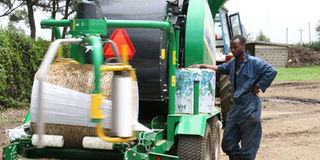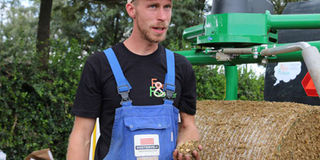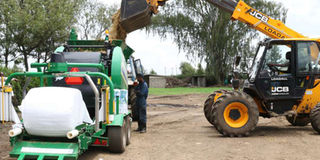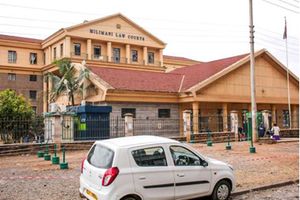Premium
Storing silage in pits is out of date; savvy farmers now bale it

An employee looks on as the silage baling machine works at Chemusian Farm in Nakuru. The farm has mechanised its daily operations such as milking, distribution of silage and now baling and packaging of silage. PHOTO | LEOPOLD OBI | NMG
What you need to know:
- Eric Dejon bales silage for large-scale farmers in a practice that is gaining currency across the country.
- Harvesting maize or sorghum for making silage is ideal when their seeds are soft.
- As long as the bales are not damaged, the packed silage can stay for two years, reckons Dejon.
- Though leguminous fodder like lucerne can also be used, they are rich in proteins and low in sugars making them a bit difficult to ensile
Rumbles of a tractor rented the air on the vast Chemusian Farm in Nakuru as the machine made several trips scooping silage before feeding it into a baling machine.
The baler compressed the fermented fodder before packaging it into huge cylindrical rolls of 400kg each.
Erick Dejon, the operator of the baler, looked on closely at the machine to ensure all was well. At one point, he stopped it to instruct workers to move the packed fodder away from the machine.
“We make and pack silage in bales for large-scale farmers. We also grow our own maize for silage-making. But right now we are here to offer baling services,” said Dejon, who works at Fodder Innovation Team.
Situated some 15km from Nakuru Town, Chemusian is an expansive dairy farm hosting some 2,000 dairy cows of Friesian and Jersey breeds on over 150 acres.
The farm has mechanised its daily operations such as milking, distribution of silage and now baling and packaging of silage.
The farm has set aside several acres of land for growing maize for silage-making to supplement natural pasture. The silage, which also comes handy during droughts, is further sold to other dairy farmers.
Currently, it is preparing the fodder that would be used after the current rainy season.
“We work with farmers who own at least 50 acres,” says Dejon, adding that they charge Sh1,000 per bale when hired to do the work.
The silage is prepared the usual way, where a pit is dug out and then a polythene sheet placed on the floor and walls.
The walls are covered by the polythene to a metre-high so that the forage does not come into contact with soil.
The sliced fodder is then put in the pit as it is compressed and molasses added to aid fermentation.
The molasses is, however, first diluted with water at a ratio of about 1:2 and sprinkled evenly over the forage layer using a garden water sprayer.

Erick Dejon, who owns the baling equipment and machinery at the farm explains a point on the process, with baled silage just behind him. The baled silage, which also comes handy during droughts, is further sold to other dairy farmers. PHOTO | LEOPOLD OBI | NMG
Apart from molasses, other additives like common salt, formic acid, lime or urea can also be used to enable good fermentation process.
The more molasses one adds, the faster the acidification and preservation process will occur.
LAST FOR TWO YEARS
The fermented silage is normally baled after six months when mature. Once baled, the silage can be stored for about two years so long as it remains properly wrapped to prevent it from decomposing.
“Silage should be prepared when there are minimal rains. In rainy periods when the fodder is too wet, containing more than 70 per cent water, it is advisable to wilt it in the sun first,” says Felix Opinya, a livestock expert from Egerton University.
But silage-making is not a new practice among local dairy farmers and pasture growers, but most farmers manually make their silage and don’t bale it.
“Normally, silage is made in pits where it is covered with polythene bags or put in drums. But we are introducing mechanisation in the silage-making process, which can either be done right from the start on the farm from harvesting of the maize or after the silage has already been fermented like in the Chemusian Farm case,” explains Dejon.
Dejon and his team began silage packaging in 2015 where they packed the feeds in airtight drums. But they later abandoned it for a less cumbersome mechanised packaging.
The baling tractor compresses the silage into tight 400kg bales each, which are easily transportable on trucks. The machine can do 45 bales an hour or about 400 bales a day. “Since maize silage contains both the corns and the stalks, one needs a good machine capable of cracking the corn for easier digestion,” says Dejon.
The team sells 400kg of bale for Sh5,000 translating into less than Sh15 for a kilo of the silage, which is a better deal compared to Sh25 for a kilo of hay.
As long as the bales are not damaged, the packed silage can stay for two years, reckons Dejon.
“After fermentation, the silage is normally well-preserved so that no air comes in. When packed properly, it becomes easily transportable and marketable.
Jos Creemers, a senior dairy sector consultant at Pro-Dairy East Africa, explains that maize silage is nutritionally richer compared to others made from Boma Rhode grasses or Lucerne.
This is because when making maize silage, both the maize stalks and the corn are harvested together. The corn provides the starch required by the cows to produce milk while the stalks provide sugars, he pointed out.
REDUCING COST OF MILK PRODUCTION
With silage, Creemers notes, a farmer spends less on dairy meal as cows would consume less of it and produces milk at a less cost per litre.

Feeding silage into the baling machine in the farm in Nakuru. The fermented silage is normally baled after six months when mature. PHOTO | LEOPOLD OBI | NMG
Harvesting maize or sorghum for making silage is ideal when their seeds are soft, but not milky when squeezed open. This is at about four months when their stalks are still green.
“When harvested at the right stage, you’ll have more starch than sugar which gives you the milk. With enough top-dressing, you’ll have proteins, but generally, protein is low in silage but you’ll still have enough which reduces your expenditure on dairy meal,” Creemers explains.
Philomena Serem whose Plateau Dairy Farm in Ainabkoi, near Eldoret hosts 61 dairy cows, says growing maize for silage is far profitable compared to for human consumption.
“Dry maize prices are quite low and are often fluctuating which makes maize for silage farming better,” says the farmer whose, 30 lactating cows produce 560 litres daily.
According to Creemers, to grow best maize for silage, a farmer needs to top-dress the maize with CAN fertiliser. Top-dressing gives the plants proper nutrient content.
“The maize is harvested when the corns are dry enough. Maize cobs give starch value to the feed while the wet stem is needed for water and sugars which aids fermentation,” he points out.
Opinya says crops such as maize, sorghum, oats and pearl millet are suitable for ensiling because they contain fermentable carbohydrates (sugar) necessary for bacteria to produce sufficient organic acid that acts as a preservative.
“Though leguminous fodder like lucerne can also be used, they are rich in proteins and low in sugars making them a bit difficult to ensile,” explains Opinya.
Cosmas Muchina, a Monitoring and Evaluation officer at the Netherlands Development Agency (SNV) says that the agency is working with dairy farmers to provide solutions to reduce the cost of milk production at the farm level.
“We hope to see that farmers are able to take up silage as a more quality forage and as a means to lower cost of producing milk,” he points out.
****
Milk pricing
- Laban Tanui, the chairman of Eldoret Dairy Farmers Association, notes that the biggest challenge in the dairy industry is low milk prices because processors buy milk at cheaper prices of less than Sh30.
- Association is encouraging members to do value addition on their farms. The association is helping farmers get affordable feeds from Uganda.
- When you source feeds as a group you are able get large quantities at a reasonable price, says Tanui, whose farm pasteurises milk before selling at Sh70 a litre.





